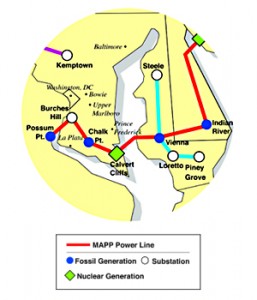PEPCO is falling down on the job
December 12th, 2010
Nearly two years ago, I attended a hearing for the Delmarva Power Integrated Resource Plan, which was the most bizarre hearing I’ve ever experienced. At that time, I raised issues about decreasing demand, entered into the record the PJM demand documents that we’d used in the Susquehanna-Roseland transmission docket in New Jersey (also PJM), and raised concerns that no SAIDI, SAIFI and CAIDI reliability info was reported. After that meeting, I presented Delmarva Power’s attorney Todd Goodman with a well-deserved “Horse’s Ass” award for his performance at that meeting. The points I’d raised at that meeting about what was missing in their “IRP” were oh-so-valid:
It took a while, but last week, the Washington Post featured an article showing that PEPCO, utility in D.C. and Maryland, and the corporate parent of Delmarva Power, has an inexcusably miserable record for outages. That’s something that’s demonstrated in the SAIDI, SAIFI and CAIDI reports! And folks, don’t go conflating transmission with distribution as the cause for the outages, as utilities would have you do. Anyway, here’s that article:
Washington Post Analysis: Why PEPCO can’t keep the lights on
As you read the article, note there’s not a word on D-E-R-E-G-U-L-A-T-I-O-N as a contributory factor, much less the primary reason.
Washington Post analysis: Why Pepco can’t keep the lights on
Moreover, Pepco has long blamed trees as a primary culprit for the frequency and duration of its outages, implying that the problem is beyond its control. But that explanation does not hold up under scrutiny, The Post analysis found. By far, Pepco equipment failures, not trees, caused the most sustained power interruptions last year.
Read the rest of this entry »
Delaware’s IRP for Delmarva
January 11th, 2010
The Delaware’s Public Service Commission (at least they still call it “public service”!!!) is holding meetings Tuesday, Wednesday and Thursday on the Delmarva Power and Light Integrated Resource Plan.
Tuesday, January 12 @ 7 p.m.
Carvel State Office Building, 2nd Floor Auditorium 820 N French Street
Wilmington – DE, 19801
Wednesday, January 13 @ 7 p.m.
DTCC – Owens Campus Theatre – Arts and Science Building
Rt 18, Seashore Hwy
Georgetown – DE, 19947
Thursday, January 14, @ 7 p.m.
Cannon Building, Ste 100
861 Silver Lake Blvd
Dover – DE, 19904
But wait… no plan has been filed, no plan is due to be filed until May…
EH?
Nothing there. So let’s look at the DPS IRP site:
Ummmmmmm… THERE’S NOTHING THERE
Really, check it out, I defy you to find one thing on Docket 10-02!
EH?
So I says to myself, I says, “There’s LOTS that needs to be a part of this Delmarva IRP!” Particularly where when I commented way back in December 2008 that demand was down and when would Delmarva produce updated forecasts and nada, they wouldn’t even address it. Todd Goodman just got pissy, to the point where he deserved one of these:
And so today, here’s what I sent in, gathering up some of the choice documents from this New Jersey Susquehanna-Roseland transmission fight, and wrapped it up and tied it with a bow:
Overland IRP Comment – 1-11-10
Exhibit C – MAPP Request to Suspend – Jan 8, 2010
Exhibit D – PATH-VA Press Release – Withdrawal 12-29-09
Exhibit E – PJM PATH Sensitivity Analysis & Cover Letters
Exhibit F – Letter NJ Comm. Fiordaliso – Official Notice 1-6-10
Exhibit G – Offshore wind and transmission Memorandum of Understanding
So now it’s your turn — it’s a blank slate!
Send Comments on Delmarva’s nonexistent IRP to:
ruth.price@state.de.us
Be sure to note on the Comment that it’s for IRP Docket 10-02.
EH?
Baltimore: Rally on Tuesday — say NO to transmission for coal!
November 29th, 2009
It’s so good to be home … for a second or so, that is, before the CapX 2020 Brookings public and evidentiary hearings start. For more on that, go to NoCapX 2020!
PJM’s Mid-Atlantic Power Pathway is in the news again… or is it PEPCO… or is it Delmarva Power… yes, another stupid transmission idea comin’ down the pike… it’s time to say NO! to transmission for coal!
Join the “No New Coal” brigade at the rally:
Baltimore’s Preston Gardens Park
Don’t get confused by this map of MAPP — they’re now admitting that the part from Indian River to Salem “isn’t needed” and it’s only a matter of time before they figure out that a 500kV line to nowhere isn’t needed either.

From The Diamondback, the University of Maryland’s paper – YES! maybe there’s hope, maybe they’ll do a better job than we have:
MAPP and PATH: Time to draw the line
Are people starting to get it? Here’s another from the Diamondback:
Guest column: Toppling King Coal
Krishna Amin is a junior biochemistry major. She can be reached at krish121 at umd dot edu.


